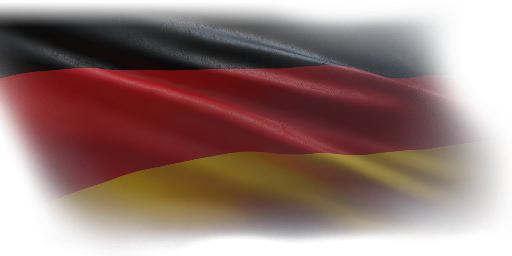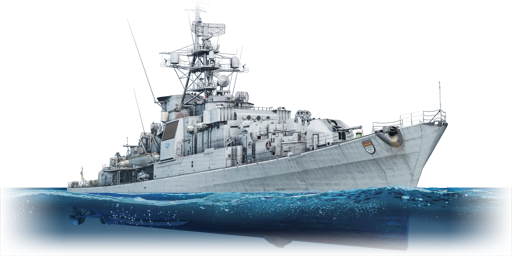

Coastal Fleet
Köln
V
Rank
AB
4.3
RB
4.3
Battle rating
Germany
Game nation
Frigate
Main role
320,000

Research
860,000

Purchase

FRG
Operator country
General information
Specification
Armour
Hull
16 mm (steel)
Superstructure
4 mm (steel)
Number of sections
6
Displacement
2,969 t
Crew
238 persons
Max speed
Forward
59518361 km/h
Backward
25223526 km/h
Primary armament
2 × Turret — 100 mm/55 MLE model 53 cannon
Ammunition
1,000 rounds
Reload
basic crew → aces
1.3 → 1 s
Vertical guidance
-5 / 90°
Turret Rotation Speed
Horizontal
40344034 °/s
Vertical
2924.72924.7 °/s
| Ammunition | Type | Armor penetration (mm) at a distance: | |||||
|---|---|---|---|---|---|---|---|
| 100 m | 1000 m | 2000 m | 3000 m | 4000 m | 5000 m | ||
| HE | 24 | 24 | 24 | 24 | 24 | 24 | |
| HE-VT | 22 | 22 | 22 | 22 | 22 | 22 | |
Secondary armament
2 × Turret — 2 × 40 mm/70 MEL58 mounting
Ammunition
8,000 rounds
Belt capacity
4 rounds
Reload
basic crew → aces
0.3 → 0.25 s
Fire rate
240 shots/min
Vertical guidance
-13 / 85°
Turret Rotation Speed
Horizontal
9580.89580.8 °/s
Vertical
9580.89580.8 °/s
| Belt | Belt filling | Armor penetration (mm) at a distance: | |||||
|---|---|---|---|---|---|---|---|
| 10 m | 100 m | 500 m | 1000 m | 1500 m | 2000 m | ||
| HEF-T | 4 | 4 | 4 | 4 | 4 | 4 | |
| HE-VT | 5 | 5 | 5 | 5 | 5 | 5 | |
2 × Turret — 40 mm/70 MEL58 mounting
Ammunition
4,000 rounds
Belt capacity
4 rounds
Reload
basic crew → aces
0.3 → 0.25 s
Fire rate
240 shots/min
Vertical guidance
-13 / 85°
Turret Rotation Speed
Horizontal
9580.89580.8 °/s
Vertical
9580.89580.8 °/s
| Belt | Belt filling | Armor penetration (mm) at a distance: | |||||
|---|---|---|---|---|---|---|---|
| 10 m | 100 m | 500 m | 1000 m | 1500 m | 2000 m | ||
| HEF-T | 4 | 4 | 4 | 4 | 4 | 4 | |
| HE-VT | 5 | 5 | 5 | 5 | 5 | 5 | |
Additional armament
Setup 1
2 × 533 mm Mark 35 torpedo
Setup 2
10 × Mk.6 depth charge
Setup 3
2 × 533 mm Mark 35 torpedo
10 × Mk.6 depth charge
10 × Mk.6 depth charge
Setup 4
96 × 375 mm M/50 Bofors anti submarine rocket launcher
Setup 5
96 × 375 mm M/50 Bofors anti submarine rocket launcher
10 × Mk.6 depth charge
10 × Mk.6 depth charge
Setup 6
96 × 375 mm M/50 Bofors anti submarine rocket launcher
2 × 533 mm Mark 35 torpedo
2 × 533 mm Mark 35 torpedo
Setup 7
96 × 375 mm M/50 Bofors anti submarine rocket launcher
2 × 533 mm Mark 35 torpedo
10 × Mk.6 depth charge
2 × 533 mm Mark 35 torpedo
10 × Mk.6 depth charge
Economy
Repair cost
Basic → Reference
AB
9,930 → 12,661 

RB
14,422 → 18,388 

Crew training
250,000 

Experts
860,000 

Aces
1,800 

Research Aces
780,000 

Reward multiplier
AB / RB
230 / 440 % 

202 % 

Total cost of modifications
290,000 

434,000 

Talisman cost
2,200 

Research order:
Seakeeping |
|---|
Unsinkability | |
|---|---|
Firepower | ||
|---|---|---|
Rating by players
You must play more than 3 battles for the last week and more than 10 battles in a vehicle to rate it.
Like:
6
Armor protection:
Not enough ratings
Survivability:
Not enough ratings
Mobility:
Not enough ratings
Armament:
Not enough ratings
Balance:
Not enough ratings
Articles
No articles about this vehicle yet
Become the first author and get rewards!
Write a guide, tell about interesting historical facts, make a tutorial or simply an interesting post.
No more content